Which areas of the UK own the most gold, and how much are their collections worth?
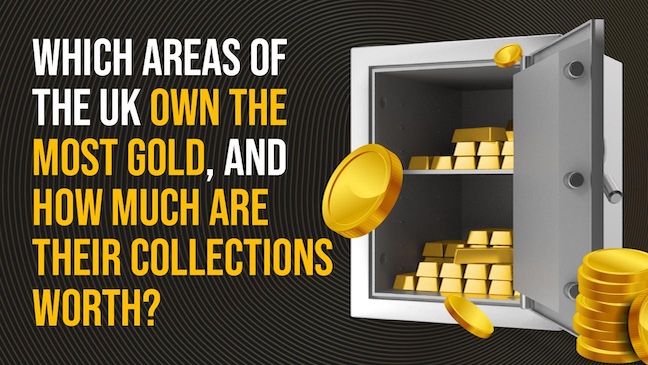
Gold has been given as a gift for centuries, and its significance and prestige worldwide show no signs of slowing down. While some people may buy gold as an individual investment, others inherit gold items from their families. Data estimates that around one in six (15%) households in Great Britain have collectables and/or valuables, but how does gold ownership differ around the country?1
To help us answer this question, we have surveyed more than 1,500 Brits, uncovering the estimated value of their collections, how they acquired them, and what they plan to do with their fortunes. By combining these findings with current gold market prices, we can reveal insights into the current state of gold ownership in the UK.
Standout stats
- Less than a quarter (23.7%) of people who have inherited gold say they will pass it on to their children or family.
- One in six gold owners has acquired their fortune in multiple ways.
- Men are more interested in selling their gold fortune (25%) than women (18%).
- 18-24-year-olds (7%) are more likely to donate their gold than over 65s (1%).
- 60% of respondents in South East England acquired gold by purchasing it - the highest proportion of any UK region.
More people buy gold than inherit it in the UK
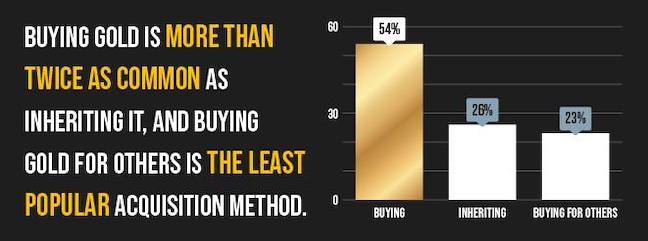
Based on our survey data, buying gold (54%) is more than twice as common as inheriting it (26%). When broken down by gender, women are more likely to be gifted gold, while men are more likely to buy it.
Buying gold for others is the least popular acquisition method (23%), with almost three-quarters (70%) of people over 65 saying they have never been gifted gold. Moreover, almost a quarter of 45-54-year-olds don't own a single gold item.
Interestingly, more people have acquired gold by purchasing it in Liverpool (63%) than in the UK's financial capital, London (62%). Our survey also revealed that South East England is the biggest buyer of gold (60%), and inheriting this precious commodity is less prevalent in Wales than in any other UK region.
Northern Ireland leads in gold collection value
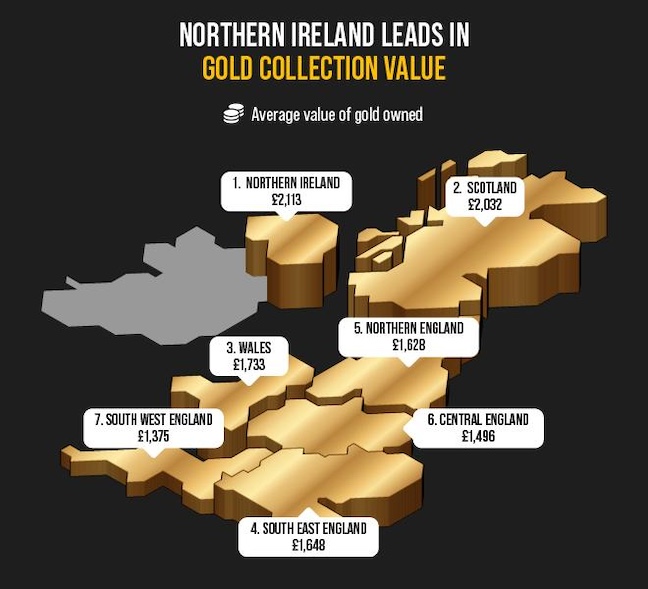
Based on our survey results, we can estimate that the average value of gold per person is £1,628. When comparing this to the UK population, the estimated value of gold across UK households exceeds £88 billion. Using our survey responses, we have calculated the average ownership values of gold across the UK by region.
While respondents in South East England had the highest number of individual gold owners whose collection exceeds £10,000, Northern Ireland has the highest figure when looking at the average value of gold owned across the region (£2,113). The high-value collections are likely the result of a long-standing mining history, dating back to Celtic times.2
On the other hand, South West England has the lowest average gold collection per person (£1,375), with almost three-quarters (70%) of all individual collections being worth less than £1,000. Central England (£1,496) is the only other UK region where the average value of gold owned is lower than the UK average per person (£1,628).
How does gold value differ between acquisition types?
Gold can be obtained in various ways, from purchasing to inheriting it, but how does this affect your collection’s value? Our survey results reveal the difference in estimated value across a series of demographics.
Buying gold is popular among Gen Z and Scots
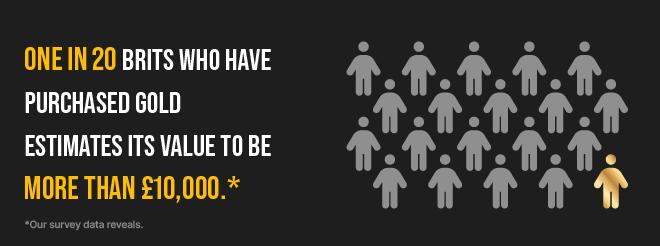
Our survey found that one in 20 Brits who have purchased gold estimates its value to be more than £10,000.
Gold purchases are popular among young adults, with over half of all 18-24-year-olds having purchased an item of gold. Given the country's economic instability, younger generations might be seeking financial security, and gold is a tried and tested investment.3 Of the 18-24-year-olds surveyed, over four-fifths (85%) estimate their purchased gold to be worth more than £100.
Regarding geographic location, Scottish respondents have higher estimated values of purchased gold than others. More than a sixth (17%) of all Scots who have bought gold estimate its value at more than £5,000.
Heirloom gold has the highest value
Inherited gold is Britain's second most common acquisition method (26%). Based on those surveyed, the average value of inherited gold (£2,501-£5,000) is 20 times more than purchased gold (£100-£250). Internal insights show that gold prices have increased by more than 1,100% since 2000, from £6.08 per gram to £78.84 in 2025. With this in mind, it is no surprise that people are more likely to inherit a high-value gold collection rather than purchase it.
Surprisingly, a third of all 25-34-year-olds have already inherited gold, which is the most considerable percentage of any age demographic. In the battle of the sexes, the average value of inherited gold for women (£2,501-£5,000) is five times that of their male counterparts (£501-£1,000).
In terms of geographic demographics, the estimated value of inherited gold is lowest in Wales and Northern England, with these regions occupying the two highest percentages of gold worth less than £100. On the other hand, one in five Glaswegians own an inherited gold collection valued at more than £5,000.
Gifted gold is less valuable than inherited pieces
Of all the methods of gold acquisition, being gifted it (outside of an inheritance) has the lowest estimated value. The rise in gold prices over the years makes it more expensive to buy, and because of this, there has been a noticeable shift in the number of small gold purchases.4 Three-quarters (75%) of UK respondents estimate their gifted gold collection is worth less than £1,000.
Of all the age groups, 35-44-year-olds have the highest percentage of gifted gold with collections worth more than £10,000 (5%). Additionally, there is a generational difference in the value of gifted gold, with 18-24-year-olds having a higher average collection value (£1,001 - £2,500) than those over 65 (£100 - £250). This could be explained by the fact that younger generations have been gifted gold for big life events, whereas older generations may have given these assets away.
Wales is the only UK region where the average value of gifted gold (outside of an inheritance) is less than £100. On the other hand, Newcastle is home to the most generous gold-givers, with 7% of all respondents gifted gold (outside of an inheritance) worth more than £10,000.
The value of gold is steadily increasing
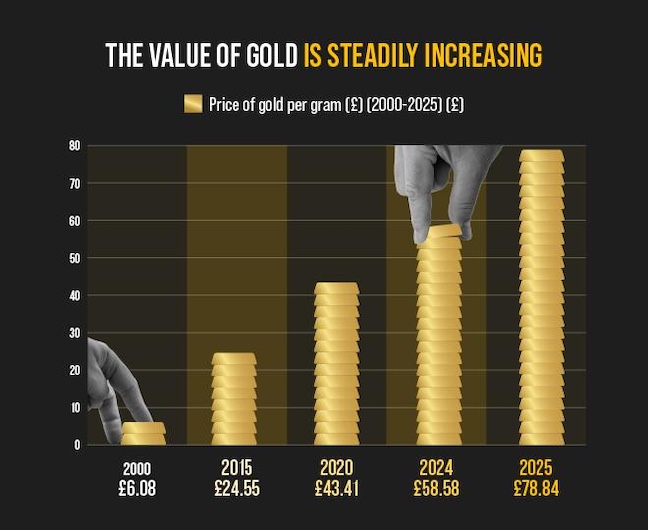
It's no secret that the value of gold is constantly shifting. In the last 20 years, the price of gold has gone from just over £6 to almost £79 per gram, which is fantastic news for anyone with historic gold. Whether it be a necklace, bracelet, or ring, if you inherited gold in 2000, your collection could be 13times more valuable today.
Even if you obtained your gold wealth last year, its value has increased by almost 35%, according to the change in gold prices. For example, an 18ct bracelet worth £14,172 in 2024 is estimated to have a value of more than £19,000 as of June 2025.
Which UK areas are spending the most on gold today?

Insights from The Gold Bullion Company show that people all over the UK are purchasing gold, with some areas spending more than others. Over the last year, London has occupied the most significant percentage of total gold orders (8.25%). However, Cambridge’s orders are valued higher, making up over 9% of the total revenue for orders across the country, compared to London (7.8%).
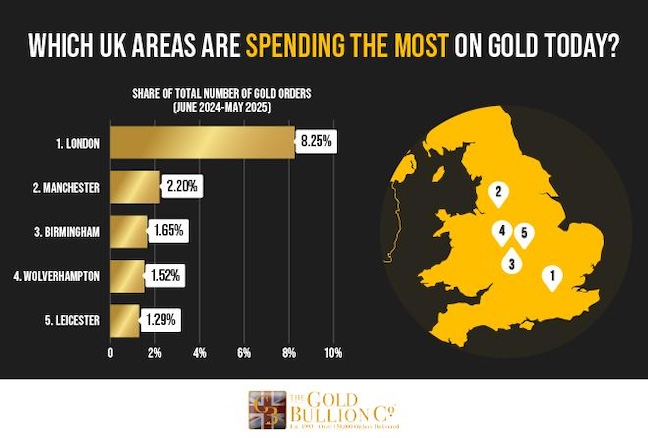
UK gold owners are more likely to keep their treasures in the family
From the fluctuating price of gold to family history, knowing what to do with your gold can be difficult. Our survey results show that a fifth of gold owners are undecided about what they want to do with their collection. People from North England are the most unsure about what to do with their gold items, with Newcastle (34%), Liverpool (32%), and Sheffield (32%) making up the top three highest percentages in this regard.
While ‘donating it’ is the least common response across respondents (3%), those who have bought gold (40.5%) are more likely to donate it than people who have been gifted it (29.7%).
Despite men being more interested in selling their gold fortune (25%) than women (18%), most gold owners would rather keep their collection in the family (44%) than sell it (21%).
Less than a quarter (23.7%) of respondents who have inherited gold say they will pass it on to their children or family. Having said this, half of all gold owners in South West England plan to pass their collection on to their family - a bigger percentage than in any other UK region.
Cultural traditions around gold giving
In the UK, gold is synonymous with fortune and prestige, but it is used and distributed differently across cultures. Gold can come in many shapes and sizes, from jewellery pieces to solid bars, but what traditions exist worldwide regarding this precious commodity?
Europe
Across Europe, gifting gold jewellery during significant life events is a common practice, most notably at weddings. Passing down gold items is also standard across the continent, with this type of inheritance being seen as a secure investment opportunity.
While some continent-wide traditions exist, there are also some regional differences. Many Southern European families see gold as a symbol of prosperity. As a result, people buy gold coins for newborns as a form of good luck. On the other hand, Eastern European countries associate gold more with religion and spirituality.
Asia
Gold is deeply rooted in Asian culture, demonstrated in everything from jewellery to architecture, like the world-famous Shwedagon Pagoda. Additionally, during the Indian festival of Diwali, gold gifts are encouraged. The same goes for those celebrating Lunar New Year, as gold is seen as a lucky way to enter the new calendar year. In addition, gold items are frequently worn during festive ceremonies across Central Asian countries, like Kazakhstan and Uzbekistan.
Africa
Across Africa, gold is predominantly associated with power and wealth. Royal Ghanaians wear gold during public events, displaying their prestige and authority to the Ashanti people. In Egypt, grooms traditionally gift the bride a set of gold jewellery, known as El Shabka, before the wedding day.
In East African countries like Ethiopia and Eritrea, gold is synonymous with religious traditions, including pendants and crosses.
South America
Due to their high value, gold coins and jewellery accumulated by families across South America are often kept as an economic safety net. Aside from this, gold jewellery is inherited by females from their mothers as a form of cultural identity and family pride.
Jewellery isn’t the only type of gold-related history in South America. One of the most well-known gold-related myths is that of El Dorado, a city of gold that has inspired numerous stories and expeditions, and is believed to exist in Colombia.
Australia
The gold rushes in Australia have been instrumental in this area’s economic development over the years. Some historic gold rush towns, such as Sofala, are still standing today.
The gold rush era saw many immigrants move overseas, resulting in a diverse culture, with many cultural gold traditions. Some of the most common traditions here include gifting gold as wedding and christening gifts, practised by the Filipino-Australian and Greek-Australian populations.
Methodology
We ran a survey asking respondents which types of gold they own, their estimated gold value, and what they plan to do with their fortune. We asked each respondent their age and gender, as well as which region and city they lived in. After filtering respondents with a screening question, the sample included 1,501 responses.
Survey data from the Channel Islands was excluded due to low response rates.
We used insights from The Gold Bullion Company to find the share of total gold orders by value and the share of the total number of gold orders between June 2024 and May 2025, broken down by area.
We took the midpoint of each respondent’s estimated gold value to calculate the average gold value per person and the average gold value per region.
We used The Office for National Statistics: Estimates of the population for the UK, England, Wales, Scotland, and Northern Ireland to find the population of UK adults (18+) and multiplied this by the average gold value per person to calculate the average value of gold across UK households.
We used insights from The Gold Bullion Company to find the price of gold per gram (£) for the following dates:
1The Office for National Statistics: Physical wealth: wealth in Great Britain
2British Geological Survey - Northern Ireland
3Master Investor: Why Gen Z and Millennials Are Buying Gold
4This Is Money: Britons cash in on gold price boom by selling it to the Royal Mint























